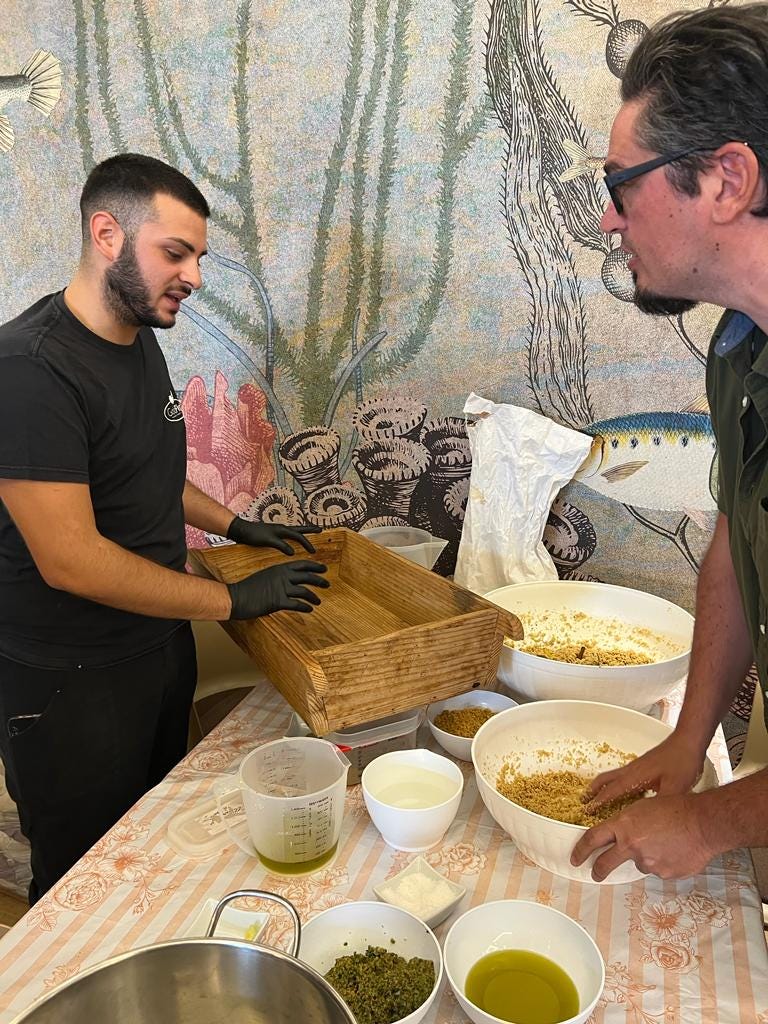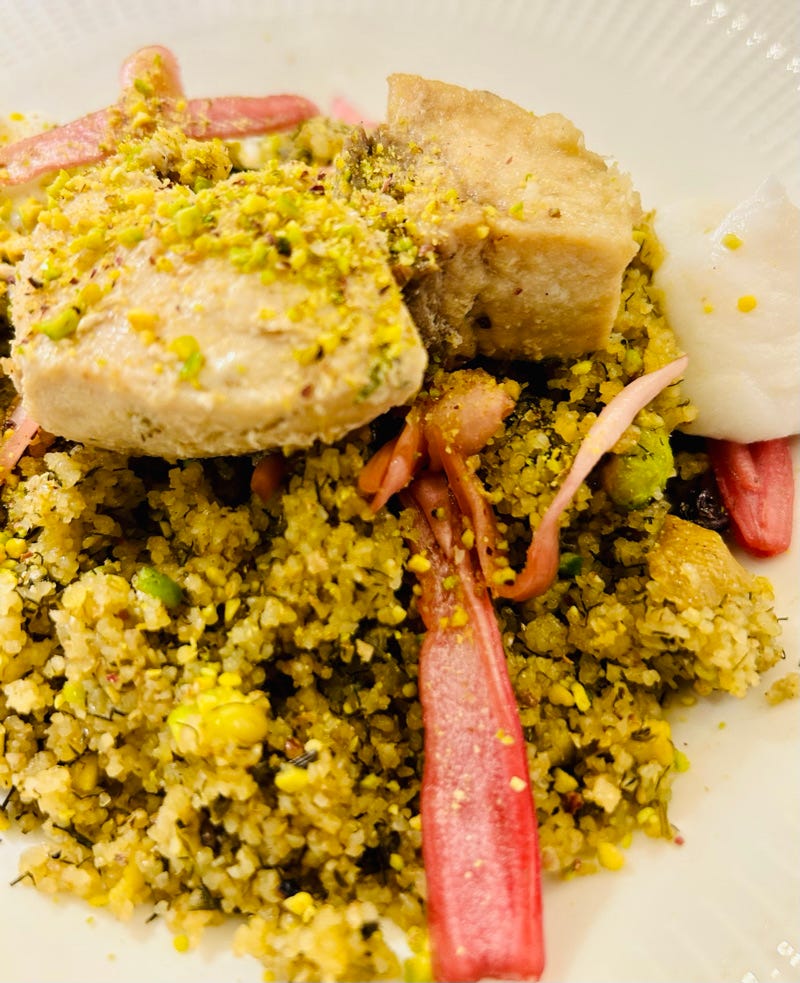I have a very vivid memory from my childhood of waking up in my grandparents house in Sicily, going down the stairs into the kitchen and seeing my aunt Rosetta sitting at the table with a large bowl in front of her and a jug of water. She had one hand flat open inside the bowl and she was moving it in a circular motion repetitively. I had no idea what she was doing, but never questioned it as it was something I had seen her do so many times before. Now I know that what she was doing was the first step of the long journey into hand made couscous.
You might be familiar with couscous as a staple of the cuisines of North Africa, from Morocco to Libya, but actually couscous is very traditional to the western part of Sicily too, where my mother’s family is from. Around the Trapani area it is common to make couscous and to eat it with a delicious and rich fish broth (even tho meat broths are not uncommon especially when you travel inland).
According to Wikipedia:
The word "couscous" (alternately cuscus or kuskus) was first noted in early 17th century French, from Arabic kuskus, from kaskasa 'to pound', and is probably of Berber origin. The term seksu is attested in various Berber dialects such as Kabyle and Rifain, while Saharan Berber dialects such as Touareg and Ghadames have a slightly different form, keskesu. This widespread geographical dispersion of the term strongly suggests its local Berber origin, lending further support to its likely Berber roots as Algerian linguist Salem Chaker suggests.
France started its colonial campaigns in North Africa in the mid 19th century, and that is probably the reason why the “frenchified” word couscous is the one that has become the standard, at least in the “western” world. Interestingly enough the Sicilian term for it (cuscusu) is more similar in spelling to its original Arabic and Berber names.
Couscous is basically a type of pasta, made of semolina flour mixed with water. In the Sicilian language there is a verb for that precise gesture I saw many times as a child: ‘ncocciare. It’s the process of adding water to semolina flour little by little, while moving the hand through it, in order to form the little tiny spheres that make your couscous. You decide the size of your couscous according to how much water you add (the more water you add, the larger the spheres).
Following Trapanese traditions, once the little spheres are formed, they get sealed with oil, dressed and steamed. After steaming the couscous, you soak it with some rich fish broth and let it rest so it absorbs the liquid and grows in volume. Finally you serve the couscous with additional fish broth on the side and pieces of fish you have used to make the broth. It’s up to personal taste whether you like your couscous on the dry side or almost soupy. It’s a huge amount of work and a whole day operation, especially if you make the couscous and the fish broth from scratch, but the result is worth every minute of it!
If you are not very fond of couscous and all you have tried is the dry precooked stuff you buy in the shop, probably in the shape of not very exciting cold salads, then let me tell you that what I am talking about is a very very different experience, and I hope I can encourage you with this post to try and find some handmade couscous whenever you get a chance! You will probably not find couscous Trapani style anywhere outside of the region, but hopefully you will be able to find some restaurants that serve some beautiful Moroccan or Tunisian couscous near you.
If you follow me on my social media, you’ve probably heard me talk about couscous before, and I often use it to describe the deep influence of the Arabic world on western Sicily. It would be easy but quite simplistic and chronologically incorrect to claim that couscous came to the island with the Moors when they conquered Sicily in the late Middle Ages. This assumption doesn’t quite fit the chronology of the history of couscous itself, and it also doesn’t explain the fact that it’s only present on the west coast of the island.
I don’t think we have a precise answer to where from and how couscous came to Trapani but it’s more likely to have happened between the 16th and 18th centuries. There are many theories, some more historically based, some more romantically conceived, stories of pirates, coral fishermen, black enslaved cooks etc…
All these stories and legends highlight the complexity of the interactions between Sicily and North Africa well after the Moors had been expelled. As a matter of fact Trapani is closer to Tunis than it is to Naples and most other places in Italy, and there was a time when migration actually went in the direction of Sicilians going to Tunisia in search of better life in the French colony (Tunisia became independent in 1956!).
Today unfortunately the sea that separates North Africa and Sicily is known for being one of the easier routes into Europe, and the tragic place were so many migrants coming from the African continent lose their life as they attempt the crossing on boats that resemble flimsy rafts.

The old tradition of making couscous in the Trapani area is something that got a bit lost in my family after zia Rosetta passed away, and it was always on my mind to learn to make it. I actually made it a couple of times on my own before but I really wanted to do it together with someone that had the experience and knowledge of it. So last summer, thanks to my childhood friend Adriana, I was able to visit the kitchen of the ristorantino L’amuri in my grandfather’s hometown San Vito Lo Capo. There I met up with chef Giuseppe Salmeri, winner of several editions of “best couscous” at the incredibly popular couscous festival in San Vito lo Capo (during this yearly festival many chefs from different part of the Mediterranean compete in creating the best new couscous dish). Chef Salmeri and one of his sous chefs Salvatore D’amico shared very generously with me some of the secrets of their couscous and walked me through the phases of making it from scratch.
I’m a musician and I feel quite intensely through tact and my hands, something that translates very powerfully in the kitchen as well. Being able to put my hands into the water, oil and semolina, and learning this ancient gesture of shaping couscous was a powerful moment for me, connecting to my long gone zia and the traditions of where my family came from. Later that night we came back to the restaurant to try some of the award winning contemporary couscous created by chef Salmeri, like the dish called “La mia Sicilia”, made with pistachios, capers, basil, currants, wild fennel and sousvide cooked sword fish.







I love this post! I am from a Sicilian family (from Augusta) but never heard of couscous until 1973, when I was a teen on an exchange program to Kairouan, Tunisia. The family who hosted me had a Bedouin woman who helped around the house. I went with my Tunisian family to their farm, where wheat was being harvested and dried. Then back to our house, where I helped to mix the wheat flour with water and rub it across a large wooden sieve where the couscous pieces fe onto a clean sheet. It was dried on the roof for a few days, then stored in huge clay jars. My "Maman" made the sauce with either mutton or fish, in a tomato broth with chickpeas, onions, hot pepper, various veggies. It was in a special pot, with the dry couscous sitting in a top portion (like a double boiler) with holes in the bottom of it. The stew cooked under neath it so that the steam cooked the pasta. All served together with extra sauce and a bowl of harissa. Fantanstic! I have been trying to imitate it for 50 years!
Thanks for these wonderful history lessons!
I find anything involving teasing the right amount of gluten out of wheat flour is better learned through the hand than the eye or brain -- pastry, bread, pasta, etc.